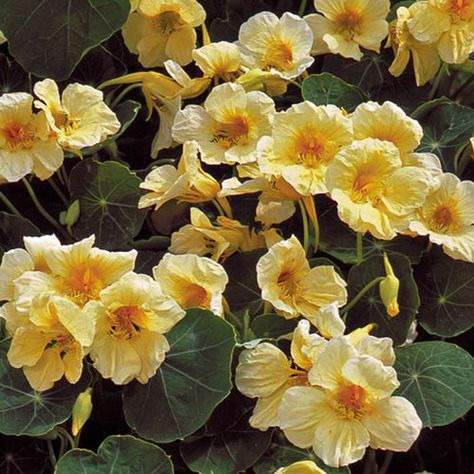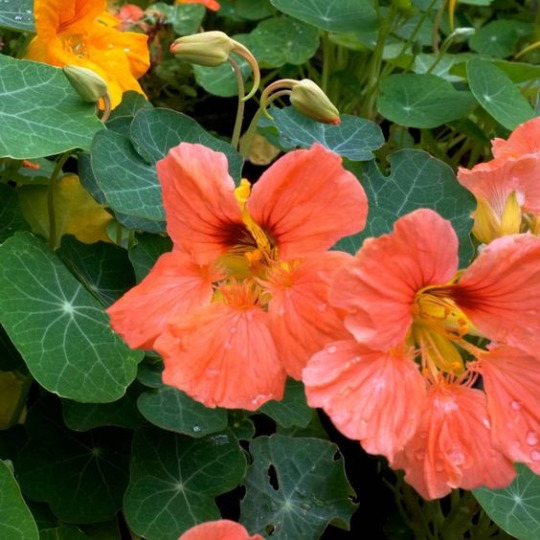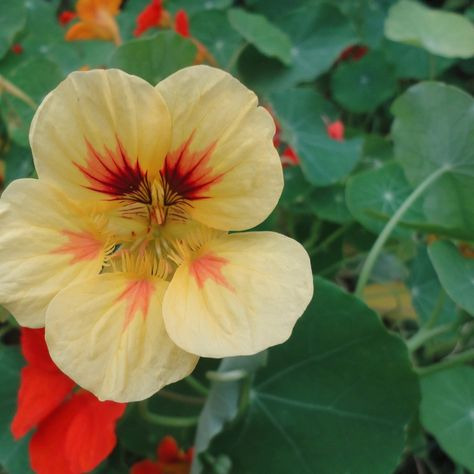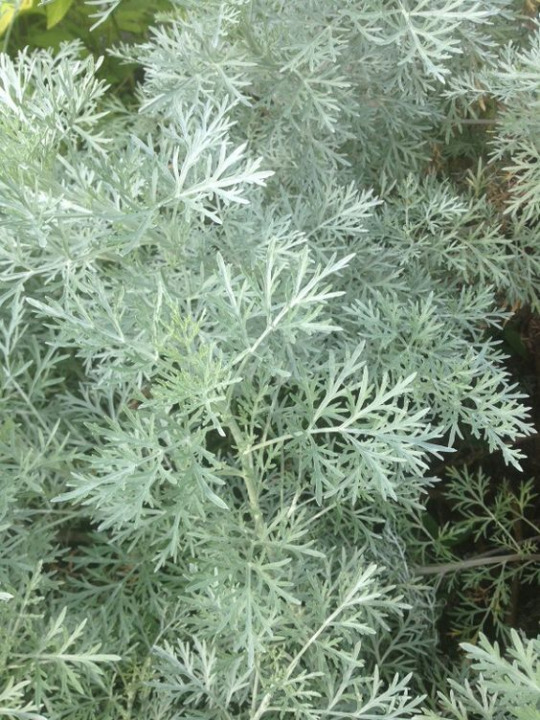#companion planting
Text

879 notes
·
View notes
Text

55 notes
·
View notes
Note
Do you have any advice for companion herbs for key lime tree? My google search says rosemary, but that needs WAY less water than the tree, so I am confused and going to a better source. . .lol, any advice?
Holy cow, you have fruit tree charts!!!!!!! Aw man, this blog rocks!!!
Key lime anon, btw. This blog is amazing!!!!!
We're happy we can be helpful! (And pretty honored we're you're "better source"!)
For anyone else interested, here is the post with charts.
- Mod J
56 notes
·
View notes
Text

All of the magical beans I've sown + how they look planted in the strawberry beds, complete with sticks to climb on!
#if this setup works this is going to be my new thing#and I think it will work because strawberries will keep moisture and protect the ground from drying out while also preventing weeds#and their roots are shallow so I don't think they'll disturb the beans at all#beans don't care that much for nitrogen so it's no problem if strawberries take it out of the ground#in fact beans will give extra nitrogen to the strawberries when they die in the fall#this might be perfect#we will see tho!!!!!#its an experiment!!!!!#growing food#gardening#beans + strawberries as neighbour plants#companion planting
41 notes
·
View notes
Text
So we have our fruit trees all picked out, and we have two apples and a plum already, so it's time to start thinking about companion planting.
One of the only plants in the yard when we bought it was a but-ton of...well they're certainly an allium. I think they're garlic-chives. They look like garlic chives.

They're short, and fairly pretty, and supposedly taste halfway between a garlic and an onion, which sounds excellent. I didn't harvest any this fall, so I'm not completely sure.
Anyways, that should help keep apple scab away. Harelson, Honeycrisp and Prairie Spy are all supposed to be reasonably resistant, but hey, the chives are already there and growing with fervor, so might as well lean into it.
One thing I want to actually plant is a bunch of nasturtium






Aren't they cute? They're more or less a groundcover, but with lots of added bonuses. Like many groundcovers, they shade the soil to prevent excess evaporation, and we've had a series of dry summers I don't expect to end any time soon. They also break down to enrich the soil in the fall. They're an annual, but readily self-seed so you can more or less plant em and forget them. The pretty waterlilly-like leaves are a peppery addition to salads or sandwiches, and their seeds can be used to make a sort of caper-like thing.
Most importantly, the plant deters insects that might damage the apple tree, while feeding bees, hummingbirds, and being an important egg host for butterflies.
I have no idea what colors I'd get the next year if I put a bunch of those next to each other, since they're going to inevitably cross-pollinate in a self-seeding situation.
One plant I was excited to discover an excuse to plant is artemesia AKA wormwood.



Wormwood is central to making vermouth and absinthe, and it's supposed to have medicinal qualities, but to be honest, I just love it as a low shrub that is VERY FUN TO PET. Seriously, some of the neighbors have one planted near the curb and my daughter and I both tend to stop and pet it whenever we pass it. Just an A+ sensation.
Utility-wise, wormwood has a very specific function- it repels codling moth, whose larvae burrow into apples, rendering them inedible for humans. We're not gonna be messing with pesticides, so we gotta think about these things.
Plus, a good garden should have a lot of different foliage textures, and this so so delightfully unique from that angle.
We're going to add daffodils to, but I have to look up when our apple trees will be blooming and find daffodils that bloom around the same time, since their primary job is to help guide pollinators to the yard at the right time.
The other main companion plant I plan to give my apple trees is yarrow, but I'm so excited about yarrow that I'm going to save that for it's own post.
39 notes
·
View notes
Text
For @superpixie42 who can totally read directions when she wants to... Song 38 for Inuparents is Love Somebody by Maroon 5! I didn't plan for it to be, but this ended up as a possibly future scene for Companion Planting. Again, will it actually end up in the story? Time will tell...
Touga shook his head in disbelief as he watched her shift her weight, finger skimming the page in a book with one hand while the other stirred something in a pot on the stove. Her tiny kitchen meant it wasn't a stretch, but her ability to multitask astounded him.
If he was honest, she astounded him.
Izayoi was… He couldn't really come up with the words to explain this woman from a world he could hardly believe existed. But here they were, several months since his arrival, learning more about the places they each called home. The similarities between Ingary and Izayoi's world were amazing, even more so than the differences. Though he was fascinated by those as well. Still more were the commonalities they themselves shared, far outnumbering the distinctions.
Izayoi hummed in thought and Touga smiled wryly. Her little habits and quirks were becoming increasingly familiar to him as the days went by. Setting his journal aside, he was waiting expectantly when she turned suddenly to ask him something. Except she hissed instead, the spoon still in her hand dripping hot sauce onto her wrist. He was up on his feet and several strides toward her before the spoon clattered on the floor. “Oh, hell,” she griped, cradling the wrist and flipping on the faucet.
Touga felt a little lost. He wasn't even sure why he'd come running. What was it he thought he was going to do? Feeling a little silly, he stooped down to retrieve the spoon, letting it slide into the sink under Izayoi's elbow as she kept her wrist under the cool running water. Startling, she reared back, bringing her back in sharp contact with his chest.
Again, his body seemed to react ahead of his brain. His arm around her waist kept her in place as he leaned forward just enough to bring her wrist back under the water. “Touga?” He hummed, focusing on gently turning her hand back and forth so he could see the extent of her injury. A red and puffy line had risen along her inner wrist, showing the path the sauce had taken across her skin. He frowned at it, the ease with which she could be injured darkening his mood along with his face. “I’m so clumsy,” she said with a nervous chuckle, bringing his attention back to her.
“Fragile too.” Except he knew that wasn’t exactly true either. This tiny woman had hauled his nearly unconscious ass out of a cave and down a steep trail. She lived entirely alone in a world that often shunned her for her brilliance. He lifted her arm up once more, watching the redness under droplets of water. “Stronger than you look,” he admitted. She shrugged a little.
Touga hesitated another moment before lifting her arm — larger hand gently encircling hers — high enough so he could put his lips to the burn mark on her wrist. She stiffened in surprise, but did not push him away. Oh so carefully, he let his tongue smoothe over it, his youki humming throughout his being. He had no idea if it would work, but he hoped it would.
After a tense silence, he lowered her arm, looking it over. While not gone, it was certainly no longer glaringly red. “I… It barely stings now.” Touga couldn’t help the smirk that came to his mouth.
“Good. I wa-”
His explanation was cut off, muffled by the pair of lips that suddenly met his own. Soft but demanding, Izayoi made it quite clear that she would not accept anything less than his surrender to this emotional dance they had been practicing for weeks now. Touga growled low, lifting her onto the edge of the sink and carding his fingers into the hair at her nape as he gave back what he was given.
Later he would acknowledge how astounding it was that she could take the lead in their dance so easily. For now, he had leading of his own to do…
#spotify wrapped#prompt ask game#dawnrider fanfiction#Companion Planting#Inuparents#Vignettes#Garden Series
6 notes
·
View notes
Text
Baby nasturtium leaves are too stinkin CUTE!!!

Nasturtiums are a beautiful, EDIBLE vining flower. They have bright orange flowers that look kinda like large pansies, with a bright peppery taste to match. They're a tasty garnish in salads, sandwiches, soups, etc!
If that's not enough, they're also great at repelling pests in the garden, so they're best planted as companions around your crops!
#botanical science#earth science#gardening#agricultural science#grow your own food#plant science#horticultural science#plant biology#permaculture#veggies#flower#nasturtium#pest control#garden facts#garden tips#seedling#spring#companion planting#plants
16 notes
·
View notes
Text
So one of the things every gardener struggles with is pests and things other than you wanting to eat your plants.
This article has a very good overview of companion planting to create trap crops and beneficial bug attractions to help combat garden pests.
6 notes
·
View notes
Text
Hydrangeas: Behind the Blooms A Personal Exploration
Join me on a captivating journey into the world of hydrangeas. From the intricacies of their soil and sunlight needs, to the delicate balance of watering, I share my triumphs and trials with these magical blooms. Discover the joy of growing hydrangeas, an
There’s something magical about hydrangeas. With their charming clusters of flowers that change colours like a chameleon, it’s hard not to fall in love. Believe me, I was smitten at first sight. As a novice gardener, I was both excited and nervous when I embarked on my hydrangea growing journey. I had my fair share of setbacks and triumphs, but trust me when I say, nothing beats the feeling of…

View On WordPress
#Colourful Blooms#companion planting#DIY gardening#fertilizer#Flower gardening#Garden Blog#garden tips#gardening#Gardening Challenges#Gardening Experiences#Gardening Journey#Green thumb#harvesting#home gardening#Hydrangea Blooms#Hydrangea Care#hydrangeas#outdoor plants#pests and diseases#plant care#Plant History#Plant Love#Plant Storage#planting guide#propagation#Seasonal Plants#Shrub Care#soil quality#sunlight requirements#watering needs
4 notes
·
View notes
Text
Companion Planting
Plants are great alone but can have different effects thanks to their neighbors. Plants that have positive effects on their neighbors are called Companion Plants. Plants that have a negative effect are Allelopathy Plants.
Different types of benefits of companion plants are:
Deterring Pests
Attracting Pollinators
Shade Regulation; such as when a tall sun-loving plant blocks the sun from a short shade-loving plant
Improved Soil Health
Weed Suppression
One example of Companion Plants are tomatoes and basil. Both are often used in the kitchen, so growing both can be useful. However, basil can be used to repel tomato-loving pests such as thrips and moths.
One example of Allelopathy Plants are beans and garlic. Beans, and other legumes such as peas, should not be planted with garlic as garlic can stunt the pea plant's growth. Garlic should also be avoided by onions as its potent stench can attract onion maggots.
Sources:
https://www.almanac.com/companion-planting-guide-vegetables
https://www.burpee.com/blog/companion-planting-guide_article10888.html
https://www.thespruce.com/what-is-allelopathy
https://www.bobvila.com/slideshow/bad-neighbors-11-plant-pairs-never-to-grow-side-by-side-51113
https://www.homesandgardens.com/gardens/garlic-companion-planting
#companion planting#companion plants#allelopathy plants#tomatoes and basil#beans and garlic#plants#botany
3 notes
·
View notes
Text

Didn’t think I would love these marigolds as much as I do. I planted them as a companion for my tomatoes, but they make me smile every time I see them in the garden. They’re just so cheerful and it’s nice to have them blooming when most things are still working on becoming real plants
#gardenblr#marigolds#companion planting#flowers#food gardening#backyard garden#roberts-island#personal#urban cottagecore#farmcore#blooms
32 notes
·
View notes
Video
youtube
How To Transplant Chamomile Seedlings In The garden
#youtube video#video#videos#gardening#gardening video#chamomile#flower#flowers#how to tip#how to tips#growing flowers#companion#companion planting
6 notes
·
View notes
Text
Rhubarb -Plant profile
Rhubarb, an overlooked powerhouse of the garden. Find out how to plant it, what to plant it with and what to do with it once ready to harvest
Rhubarb (Rheum rhabarbarum) is a versatile and hardy perennial plant that can thrive in a permaculture system. Known for its tart flavor and vibrant red stalks, rhubarb offers not only culinary delights but also various health benefits. In this article, we will explore in detail how to grow rhubarb in a permaculture garden, discuss its health benefits, share some delicious recipes, and highlight…

View On WordPress
#companion planting#edible plants#gardening#healthy eating#Nutrition#permaculture.#Plant information#recipes#Sustainability#Sustainable living
4 notes
·
View notes
Text

Marigolds 🌼
#my plants#plantblr#plants#plant#garden#gardening#flowers#flower#marigolds#french marigold#marigold#French marigolds#marigold plant#companion planting#companion plants#urban gardening#plantwave#plantcore#gardencore
22 notes
·
View notes
Link
Best (and worst) companion plants for growing peppers.
My favs:
1. Sweet Alyssum: Underplant your pepper plants with a carpet of sweet alyssum. In addition to enhancing biological control, it’s also beautiful. The small blooms of this low-growing annual plant feed a whole host of good bugs that help a gardener manage pepper pests. Parasitic wasps, syrphid flies, tachinid flies, ladybugs, and lacewings are all found sipping from the blooms. And when they’re not drinking nectar, some of these beneficial insects are eating pests like aphids, whiteflies, and thrips, while others are laying their eggs in pests like hornworms, bud worms, and fruit worms.
2. Onions/garlic/chives: Green peach aphids are among the most common pests of peppers. Interplanting peppers with members of the allium family, including chives, onions, garlic, and scallions, has been shown to deter these small insects from settling on pepper plants to feed. Plant the allium crops around and in between your pepper plants. Or plant your peppers smack in the middle of your onion crop.
3. Nasturtiums: if aphids plague your pepper plants, consider planting a nearby companion planting of nasturtiums. A favorite of aphids, the lovely round leaves of nasturtiums are much preferred by this pest. The aphids opt to feed on the nasturtiums and leave your peppers alone. Since aphids are tiny and can’t travel very far, you’ll want these two plant partners located within a foot or two of each other.
#companion plants#companionplants#companion planting#peppers#growing peppers#hot peppers#garden witch#homesteading#grow your food#grow your own food#nasturtiums#sweet alyssum
2 notes
·
View notes
